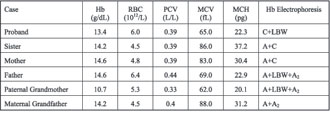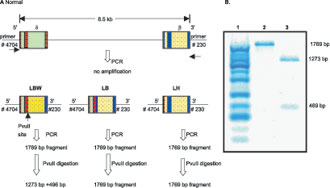


COMPOUND HETEROZYGOSITY FOR Hb C AND
Hb LEPORE-BOSTON-WASHINGTON IN A
PATIENT FROM CROATIA
Bardarova K1, Plaseska-Karanfilska D1, Preden-Kerekovic V2,
Efremov GD1
*Corresponding Author: : Professor Georgi D. Efremov, Macedonian Academy of Sciences and Arts, Research Centre for Genetic Engineering and Biotechnology, Aven. Krste Misirkov 2, POB 428, 1000 Skopje, Republic of Macedonia; Tel: +3892 239 061; Fax: +3892 115 131; E-mail: gde@manu.edu.mk
page: 33
|
|
RESULTS AND DISCUSSION
The proband is a 25-year-old patient from Croatia who has been anaemic since childhood. In 1996, during a routine checkup, he was found to have a slightly elevated bilirubin level, microcytosis, hypochromia, polychromasia and target cells. Four years later he was referred to the hospital for a detailed hematological investigation. At that time he displayed tiredness, malaise, varicose veins and high blood pressure. Ultrasound of the abdomen showed an enlarged liver with a rough parenchymal structure and without focal lesions and biliar channel dilatation. Gallbladder, biliar channels, pancreas and kidneys were normal.
The hematological and Hb analysis data of the proband and members of his family are shown in Table 1. The presence of two abnormal Hbs in the patient's hemolysate was observed by cellulose acetate and starch gel electrophoresis. The two abnormal globin chains eluted together on reversed phase HPLC.
Considering the electrophoretic and HPLC elution patterns, as well as the hematology of the proband and members of his family, the presence of a Hb Lepore was suspected. The electrophoretic and HPLC patterns of the other Hb were suggestive of Hb C. However, since the presence of Hb C is very unusual in this region, the entire coding region of the b-globin gene from the proband was sequenced. DNA sequencing analysis did indeed show the presence of the GAG®AAG mutation at codon 6 of the b-globin gene leading to Hb C. The presence of the Hb LBW gene was determined by PCR amplification using 5'd- and 3'b-globin gene specific primers, followed by PvuII digestion (Fig. 1).
Family studies showed that the Hb LBW was inherited from the patient's father who is of Croatian ancestry, while Hb C was inherited from his mother who originates from Hungary. Since Hb C has been found very rarely in this region, haplotype analyses were performed to trace its origin in this family. The data of the extended haplotype analysis of the b-globin gene cluster in this family are shown in Table 2. The Hb C variant in this family is associated with haplotype [– + + + – + + + –] (referring to HincII/e, HindIII/ Gg, TaqI/3'Gg, HindIII/Ag, HincII/yb, HincII/3'yb, AvaII/b, HpaI/b and BamHI/3'b polymorphisms), b-globin framework 2 and (AT)9(T)5 motif at –530 5' to the b-globin gene. The bC chromosome in this family differs from the typical African bC chromosome [11] at several polymorphic sites: TaqI/3'Gg, HindIII/Ag, HpaI/b and BamHI/3'b polymorphisms, b-globin framework and (AT)X(T)Y motif at –530 5' to the b-globin gene (Table 3). These data demonstrate that the Hb C mutation in this family has not been derived from the African bC chromosome.
Table 1. Haematological and haemoglobin analysis data of the proband and members of his family


Fig. 1. Detection of Hb LBW in the proband by PCR amplification and PvuII restriction enzyme digestion. A) Schematic representation of the methodology. B) A photograph of the agarose gel identigying the Hb LBW gene in the proband. Lane 1: DNA Ladder; lane 2: 1,769 bp PCR fragment; lane 3: 1,273 and 496 bp DNA fragments obtained after PvuII digestion.
Table 2. Extended haplotype analysis of the b-globin gene cluster of the proband and members of his family

Table 3. Comparison between the polymorphisms of the Croatian bC chromosome of the proband and the African bC chromosome

|
|
|
|



 |
Number 27
VOL. 27 (2), 2024 |
Number 27
VOL. 27 (1), 2024 |
Number 26
Number 26 VOL. 26(2), 2023 All in one |
Number 26
VOL. 26(2), 2023 |
Number 26
VOL. 26, 2023 Supplement |
Number 26
VOL. 26(1), 2023 |
Number 25
VOL. 25(2), 2022 |
Number 25
VOL. 25 (1), 2022 |
Number 24
VOL. 24(2), 2021 |
Number 24
VOL. 24(1), 2021 |
Number 23
VOL. 23(2), 2020 |
Number 22
VOL. 22(2), 2019 |
Number 22
VOL. 22(1), 2019 |
Number 22
VOL. 22, 2019 Supplement |
Number 21
VOL. 21(2), 2018 |
Number 21
VOL. 21 (1), 2018 |
Number 21
VOL. 21, 2018 Supplement |
Number 20
VOL. 20 (2), 2017 |
Number 20
VOL. 20 (1), 2017 |
Number 19
VOL. 19 (2), 2016 |
Number 19
VOL. 19 (1), 2016 |
Number 18
VOL. 18 (2), 2015 |
Number 18
VOL. 18 (1), 2015 |
Number 17
VOL. 17 (2), 2014 |
Number 17
VOL. 17 (1), 2014 |
Number 16
VOL. 16 (2), 2013 |
Number 16
VOL. 16 (1), 2013 |
Number 15
VOL. 15 (2), 2012 |
Number 15
VOL. 15, 2012 Supplement |
Number 15
Vol. 15 (1), 2012 |
Number 14
14 - Vol. 14 (2), 2011 |
Number 14
The 9th Balkan Congress of Medical Genetics |
Number 14
14 - Vol. 14 (1), 2011 |
Number 13
Vol. 13 (2), 2010 |
Number 13
Vol.13 (1), 2010 |
Number 12
Vol.12 (2), 2009 |
Number 12
Vol.12 (1), 2009 |
Number 11
Vol.11 (2),2008 |
Number 11
Vol.11 (1),2008 |
Number 10
Vol.10 (2), 2007 |
Number 10
10 (1),2007 |
Number 9
1&2, 2006 |
Number 9
3&4, 2006 |
Number 8
1&2, 2005 |
Number 8
3&4, 2004 |
Number 7
1&2, 2004 |
Number 6
3&4, 2003 |
Number 6
1&2, 2003 |
Number 5
3&4, 2002 |
Number 5
1&2, 2002 |
Number 4
Vol.3 (4), 2000 |
Number 4
Vol.2 (4), 1999 |
Number 4
Vol.1 (4), 1998 |
Number 4
3&4, 2001 |
Number 4
1&2, 2001 |
Number 3
Vol.3 (3), 2000 |
Number 3
Vol.2 (3), 1999 |
Number 3
Vol.1 (3), 1998 |
Number 2
Vol.3(2), 2000 |
Number 2
Vol.1 (2), 1998 |
Number 2
Vol.2 (2), 1999 |
Number 1
Vol.3 (1), 2000 |
Number 1
Vol.2 (1), 1999 |
Number 1
Vol.1 (1), 1998 |
|
|

